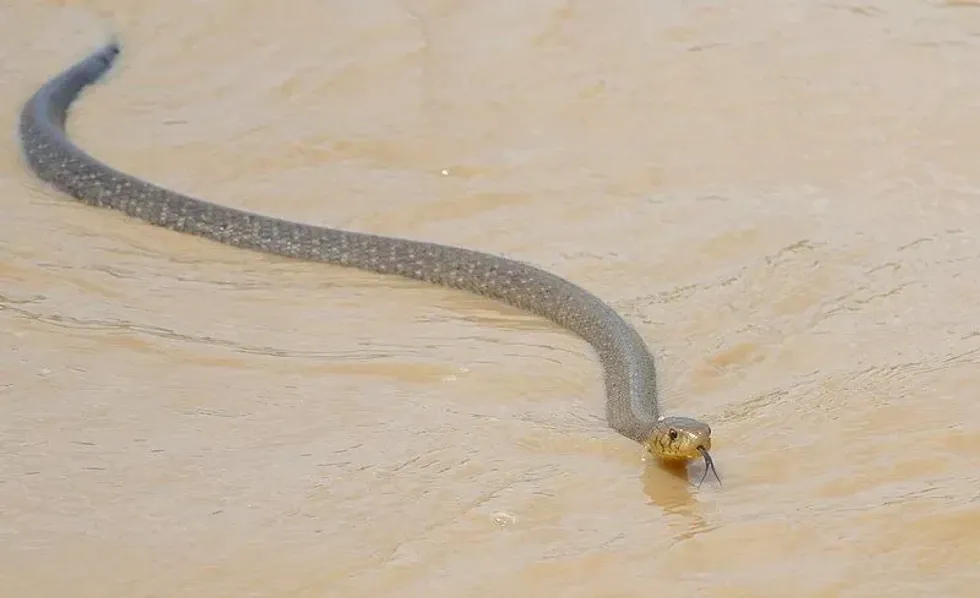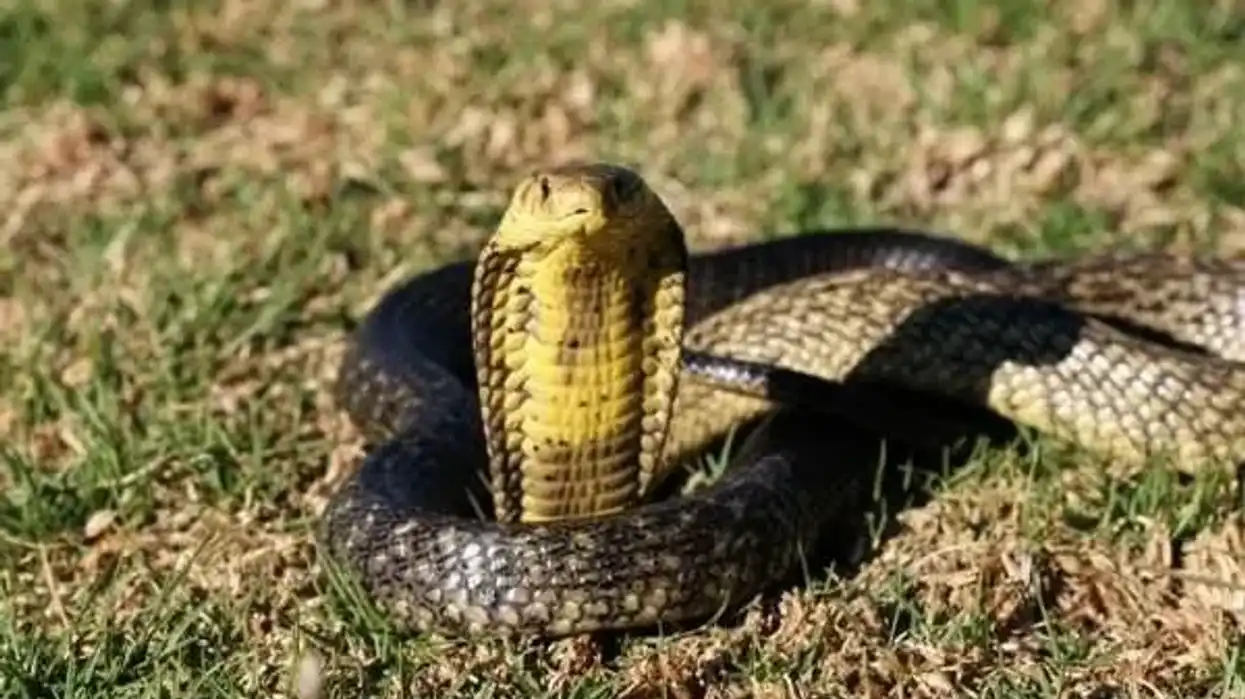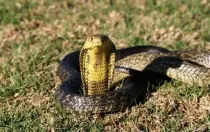Fun Forest Cobra Facts For Kids
Content
- What type of animal is a forest cobra?
- What class of animal does a forest cobra belong to?
- How many forest cobras are there in the world?
- Where does a forest cobra live?
- What is a forest cobra's habitat?
- Who do forest cobras live with?
- How long does a forest cobra live?
- How do they reproduce?
- What is their conservation status?
- What do forest cobras look like?
- How cute are they?
- How do they communicate?
- How big is a forest cobra?
- How fast can a forest cobra move?
- How much does a forest cobra weigh?
- What are the male and female names of the species?
- What would you call a baby forest cobra?
- What do they eat?
- Are they poisonous?
- Would they make a good pet?
- Did you know...
- Dangers of the forest cobra
- The forest cobra and its prey
This fact file is a compilation of all the information available on the snake named the forest cobra (Naja melanoleuca).
This reptile is a relative to king cobra and is scientifically known as Naja melanoleuca. The forest cobra is a snake species that can be found across Southern Africa, Western Africa, and Central Africa from the Central African Republic, Sierra Leone to the Republic of Congo and South Africa.
This largest true African cobra has five subspecies, the black forest cobra (N. guineensis), the West African banded cobra (N. savannula), Central African forest obra (N. melanoleuca), the São Tomé forest cobra (N. peroescobari), and the brown forest cobra (N. subfulva).
The aggressive nature of these cobras makes them unsuitable to be kept captive. Here are some of the most interesting facts about the forest cobra species. Afterward, have a look at some more interesting fact files on king cobra and Indian cobra.
Forest Cobra Interesting Facts
What type of animal is a forest cobra?
The forest cobra (Naja melanoleuca) is a snake, a reptile, native to the African Continent, is a serpent more specifically very well adapted to the wild. It is a royal and perhaps one of the most deadly predators of the forests.
Standing all mighty and tall, it is considered to be the largest of the true cobras found in the wild.
What class of animal does a forest cobra belong to?
The forest cobra (Naja melanoleuca) is a serpent belonging to the class reptilia of the phylum Chordata in the kingdom Animalia. More specifically, this reptile belongs to the family Elapidae, that is the family of venomous snakes with characteristic erect fangs.
This family of Elapidae further belongs to the order Squamata, which is the largest order of the class reptilia. It is composed of all the reptiles such as lizards and snakes, with a scaly exoskeleton. Around 10,900 species of reptiles fall in this order.
How many forest cobras are there in the world?
The forest cobra (Naja melanoleuca) is well adapted to various habitats in the warm regions of the African Continent and is found in good numbers. There is no proper count of the Naja melanoleuca population in the wild but a forest cobra survives well owing to its predatory nature.
Where does a forest cobra live?
Forest cobras (Naja melanoleuca) are exclusively found in the African Continent and are widely distributed across Central and Western Africa. It is specifically found in the Savanna and Grassland regions in various places like Equatorial Guinea, Republic of Congo, Benin, Nigeria, Central African Republic Gabon, and Cameroon to name some.
While it is not recommended, a large population of this species has been kept as captive forest cobras across the world.
What is a forest cobra's habitat?
The forest cobra (N. melanoleuca) is poikilothermic in nature and can adjust its body temperature according to its environment. Owing to this, it can be found in a vast variety of habitats, preferably geographical regions with a drier climate.
It is the only African cobra to survive in elevated forest regions.
It is mainly found in tropical and subtropical Africa usually along the streams and other river bodies. These black and white snakes are very secretive beings and hide in the holes underground and are able to camouflage very well with the dried forest leaves, twigs, and other organic debris present on the ground.
Who do forest cobras live with?
Snakes in general are not very social but shy despite being one of the most dangerous creatures. A forest cobra (N. melanoleuca) may be found alone dawdling in the forest or maybe around a few similar snakes but never in large groups.
One can find them with their mates during the mating season. Other animals usually avoid being in their territory, since these noxious beasts have a huge diet and feed on a vast variety of organisms.
How long does a forest cobra live?
The forest cobra is said to be the largest of all the true cobras found in the world. A true cobra is a predator and the only threat to them are humans.
The forest cobra snakes live for 15-25 years on average in captivity and about 35 years in the wild. These reptiles need open space for better survival and hence live longer in the wild than in captivity.
How do they reproduce?
Snakes can be both oviparous or viviparous depending upon their species. But forest cobras are oviparous and lay around 11-26 eggs at a time.
The eggs of forest cobras are pure white in color and may measure around 1.2-2.4 in (3.0-6.0 cm) long. These snakes nest in hollow trees or in termite mounds and sometimes even in the ground where the female snake creates her nests.
Before mating, they have a dance which is a form of courtship display between the female and the male cobra. These reptiles can get very aggressive during mating.
After a few days of laying eggs and an incubation period of around 80 days, hatchlings are born that can measure around 9-10 in (22.8-25.4 cm) long. Hatchlings are independent of the parent cobra and are capable of feeding on their own by birth.
What is their conservation status?
The forest cobra serpents fall under the category of Least Concern species. These snakes are highly adaptable reptiles and are found in decent numbers in their habitat.
But the records report that these reptiles have split into subspecies and their number might decline due to the loss of forest. Industrialization and expansion of the urban areas are causing an eerie disturbance in their natural habitats, which might impose a big threat to their survival in the future.
Forest Cobra Fun facts
What do forest cobras look like?
A limbless reptile with an extraordinary defense mechanism, a forest cobra measures around 8 ft (2.4 m) in length. This serpent is a close relative of the Egyptian cobra. Its specialty is the presence of a hood and a small head and wide eyes.
These snakes have a short tail and a glossy black scaly exoskeleton. The underbelly and chin have white scales and a few white patches here and there on other parts of the body.
They are sometimes also called black and white cobras or white lipped cobras. They have a set of straight sharp fangs connected to bags of venom in their mouth. And just like other snakes, these snakes also have a split tongue.

How cute are they?
Infamous for being venomous and deadly, a white lipped cobra or any other poisonous snake can never be cute. They are scary, nervous yet have a very aggressive nature.
Despite this, they hold a very important place in the food chain. A cobra can never be domesticated. It is an antisocial animal and avoids all sorts of human attention and most of us humans avoid them too!
How do they communicate?
Snakes are said to have a sixth sense, infrared vision. This enables them to sense other homeotherms and poikilotherms in their territory.
They are generally very quiet and alert but communicate through a sound called ‘hiss’. A hissing sound is an indication of a forest cobra or any other snake in your surrounding, so be careful! Besides, they are able to pick up vibrations in their surroundings and communicate through low sounds.
Cobras have a special physical feature where they spread their hood as a sign of warning. They also communicate through a special dance which is a way of courtship display during mating season.
How big is a forest cobra?
Forest cobras can grow twice, thrice the size of us humans! They are almost the same size as that of a king cobra but have varied morphological features. Forest cobras can grow up to a length of 8 ft (2.4 m), making them one of the largest true cobras found in the world!
How fast can a forest cobra move?
Cobras in general are the fastest snakes present on the globe. They can achieve an average speed of 12 mph (19.3 kph).
Sources report that they move slowly once they sense a predator in their surroundings and as soon as it has spotted the prey, with a very fast speed it latches to it, injecting its venom and killing it on the spot before consuming it.
How much does a forest cobra weigh?
These are large snakes and are heavy in weight. An average adult forest cobra may weigh around 4.4-7.9 lb (1.9-3.5 kg). Despite their heavy size, forest cobras are fast on both land and earth. Their slender body assists them well in the water body making them great swimmers.
What are the male and female names of the species?
Both males and females are referred to by the same names, male forest cobra and female forest cobra respectively. Male forest cobras are usually smaller in length than female forest cobra. Besides, the male forest cobras have a thicker tail than the female forest cobras.
What would you call a baby forest cobra?
A baby forest cobra is referred to as a snakelet, a neonate, or a hatchling. A hatchling is a size of about 9 in (22.8 cm).
Some reports have even suggested 18 in (45.6 cm) length of a hatchling. They are venomous since birth and are capable of killing a large sized vertebrate in just a blink of an eye.
What do they eat?
Forest cobras have a vast diet comprising mammals, reptiles, and aquatic animals. They can eat any vertebrate smaller in size.
They feed on amphibians, frogs, eggs of birds, large insects, aquatic crustaceans, salamanders, rodents, fishes, monitor lizards, small sized mammals, or any other small sized snake. These forest snakes play a very important role in the food chain. They feed on these pests and fast breeding organisms and keep their population in control.
Are they poisonous?
They are venomous and attack their prey by biting them with their sharp, straight fangs, paralyzing them, and later killing them on the stop with just one bite. Hence it is advisable to avoid and keep a distance from them and avoid invading their territories.
Because in case an intruder is strolling in their surroundings they get alert and defensive and will not hesitate to bite.
The symptoms of snake bite include nausea, vomiting, elevated heart rate, and ptosis. But when compared with king cobra, the king cobra is more deadly as the neurotoxin in the bite is enough to kill even an elephant.
Would they make a good pet?
They do not make good pets. They are dangerous and are made for the wild and not for our homes. They are big sized reptiles and are venomous, besides it is banned to domesticate them.
Did you know...
Cobras hold a special significant status across cultures. They are worshipped and taken as a symbol of strength and fierceness. These animals have special features for survival, giving them ferocious nature.
The anatomy of this snake is very interesting. There's an excess skin on the back of their head called a hood.
This hood is inflatable with the aid of air that is supplied through from the lungs. Their heads are flexible and their jaws can open really wide to gulp in the prey. There is a special gland called Jacobson's gland which has two hollow sac like structures present in the roof of the mouth.
It is an extrasensory organ that aids them in the sensing of smell. Their forked tongue helps in picking up the smell of their prey and sends it to the Jacobson's gland for processing.
Their body has a very long vertebral column and ribs present throughout their body from the head to the end of their tail. This structure is very flexible, allowing them to coil their bodies and fit in small pits and hollow tree trunks.
Since a forest cobra snake is venomous like other serpents, it can bite and kill humans as well just like their other prey. For this, researchers have created antivenom as a solution.
A small amount of the Forest Cobra venom is injected into the body of a relevant animal, usually a sheep or a horse. As this venom is in the system, antibodies are created in defense. Scientists extract these antibodies as antidotes against the cobra venom and administer them to the victim bitten by these snakes.
Dangers of the forest cobra
Cobras in general are venomous in nature. Naja melanoleuca is a venomous snake.
It injects its venom into the victim by biting it aggressively but is never seen spitting the venom.
Their venom consists of what is called alpha neurotoxins, which are present in all the snakes of the families Elapidae and Hydrophiidae.
This neurotoxin once goes into the system attacks the acetylcholine neurotransmitter and blocks it from reaching the postsynaptic cell, causing a blockage in transmission of electrical impulses in the nervous system of the casualty, immediately causing complications such as paralysis, respiratory failure, finally leading to death.
The forest cobra and its prey
Forest cobras can stand tall, approximately two third of their original length, and produce a hissing sound as a warning before attacking. Once they are set, they immediately attack their prey on the neck, injecting the toxins and making it immobile before consuming it.
Here at Kidadl, we have carefully created lots of interesting family friendly animal facts for everyone to discover! For more relatable content, check out these green anaconda facts and timber rattlesnake facts pages.
You can even occupy yourself at home by coloring in one of our cobra coloring pages.
We Want Your Photos!
More for You
Doctorate specializing in Veterinary Medicine

Oluniyi AkandeDoctorate specializing in Veterinary Medicine
With an accomplished background as a Veterinarian, SEO content writer, and public speaker, Oluniyi brings a wealth of skills and experience to his work. Holding a Doctor of Veterinary Medicine degree from the University of Ibadan, he provides exceptional consulting services to pet owners, animal farms, and agricultural establishments. Oluniyi's impressive writing career spans over five years, during which he has produced over 5000 high-quality short- and long-form pieces of content. His versatility shines through as he tackles a diverse array of topics, including pets, real estate, sports, games, technology, landscaping, healthcare, cosmetics, personal loans, debt management, construction, and agriculture.
Disclaimer
1) Kidadl is independent and to make our service free to you the reader we are supported by advertising. We hope you love our recommendations for products and services! What we suggest is selected independently by the Kidadl team. If you purchase using the Buy Now button we may earn a small commission. This does not influence our choices. Prices are correct and items are available at the time the article was published but we cannot guarantee that on the time of reading. Please note that Kidadl is a participant in the Amazon Services LLC Associates Program, an affiliate advertising program designed to provide a means for sites to earn advertising fees by advertising and linking to Amazon. We also link to other websites, but are not responsible for their content.
2) At Kidadl, we strive to recommend the very best activities and events. We will always aim to give you accurate information at the date of publication - however, information does change, so it’s important you do your own research, double-check and make the decision that is right for your family. We recognise that not all activities and ideas are appropriate for all children and families or in all circumstances. Our recommended activities are based on age but these are a guide. We recommend that these ideas are used as inspiration, that ideas are undertaken with appropriate adult supervision, and that each adult uses their own discretion and knowledge of their children to consider the safety and suitability. Kidadl cannot accept liability for the execution of these ideas, and parental supervision is advised at all times, as safety is paramount. Anyone using the information provided by Kidadl does so at their own risk and we can not accept liability if things go wrong.
3) Because we are an educational resource, we have quotes and facts about a range of historical and modern figures. We do not endorse the actions of or rhetoric of all the people included in these collections, but we think they are important for growing minds to learn about under the guidance of parents or guardians.







